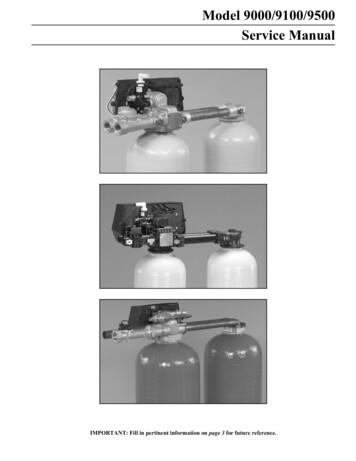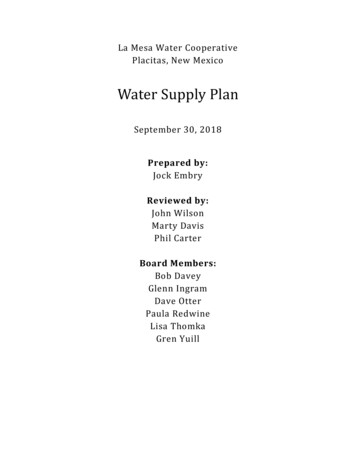
Transcription
Water and Energy in Coops: Practical PermacultureMichael (Mickey) RushMember, Chrysalis CooperativeFormer Member, MN Students Cooperative (East River Cooperative)M.S. Civil EngineeringB.S. Physics
Overview Ideologies and motivation (5 minutes) Taking advantage of the physics of heat and solargeometry (20 minutes) Energy and water projects (15 minutes) Community project-share (15 minutes) Patterns (20 minutes) Pattern Activity (15 minutes)
Four I’s of Oppression cal
Climate Change InternalInstitutionalInterpersonalIdeological
logical
What am I suggesting? Playful, creative, and silly involvement with thesystems that support our bodies Restructuring our attitudes towards time and energy,eliminate divide between: Work and leisure Nature and home Radical investment in the present and our surroundings Leading by example
Observe and interact
Capture and store energy
Use and value renewableresources and services
Use small and slow solutions
Use and value diversity
Use edges
Mechanisms of Heat Transfer
What to do with this knowledge? It has been suggested that humans prefer to be heated radiativelyvs. convectively. Think: Brisk sunny day Chilly night next to a fire Swimming on a sunny day
Cooling
Heating
Taking Advantage of Solar Geometry
Incoming Shortwave Radiation: NNθ
ωZenith Angle θNθΛ δ
Inclined Plane Slope angle (β) and aspect (α):βNα
Equivalent Slope (Lee, 1964)
The Tool Written in Python 2.7 Web interface: (Thank you, Ezra Hutcher!!!) http://science.hyperspaceweb.net/solar angle calculator/ Takes inputs of: Slope of your surface (flat 0 ) Aspect of your surface (clockwise from north) Latitude of your surface Calculates optimal solar panel angle for each day of the year
How to find slope, aspect, latitude
How to use the tool Select how many times you will adjust your panel: Never: take the average of all angles Twice per year: Switch on the spring/fall equinoxes Average the angles in between equinoxes 4x per year: Switch on the spring/fall equinoxes and on summer/winter solstices Average the angles in between equinoxes and solstices
Other tools: To estimate power: http://pvwatts.nrel.gov/pvwatts.php Live from Chrysalis: https://enlighten.enphaseenergy.com/pv/public systems/J3Sr722/overview
Back to Basics
Cold Frames
Water Projects
Outdoor shower?
Simple Gray Water Recycling System “Small and slow solutions” Daily reminder of the valueof freshwater Participation in the systemsthat sustain us
Community Project ShareCom
A Pattern Language (1977) “Towns and buildings will not be able to become alive, unlessthey are made by all the people in society, and unless thesepeople share a common pattern language, within which to makethese buildings, and unless this common pattern language isalive itself.” “The elements of this language are entities called patterns. Eachpattern describes a problem which occurs over and over again inour environment, and then describes the core of the solution tothat problem, in such a way that you can use this solution amillion times over, without every doing it the same way twice.”
South facing outdoors: Always place buildings to thenorth of the outdoor spaces thatgo with them, and keep theoutdoor spaces to the south.Never leave a deep band of shadebetween the building and thesunny part of the outdoors. Sunny place: The area immediately outside thebuilding, to the south – that anglebetween its walls and the earthwhere the sun falls – must bedeveloped and made into a placewhich lets people bask in it.
Half-hidden garden: If a garden is too close to the street,people won’t use it because it isn’tprivate enough. But if it is too far fromthe street, then it won’t be used either,because it is too isolated. Do not place the garden fully in front ofthe house, nor fully to the back. Instead,place it in some kind of half-wayposition, side-by-side with the house, ina position which is half-hidden from thestreet, and half-exposed.
Garden growing wild: A garden which grows true to itsown laws is not a wilderness, yet notentirely artificial either. Grow grasses, mosses, bushes,flowers, and trees in a way whichcomes close to the way that theyoccur in nature: intermingled,without barriers between them,without bare earth, without formalflower beds, and with all theboundaries and edges made inrough stone and brick and woodwhich become a part of the naturalgrowth.
Compost: Our current ways of gettingrid of sewage poison thegreat bodies of naturalwater, and rob the landaround our buildings of thenutrients they need.
Green house: In temperate climates, build agreenhouse as part of your house oroffice, so that it is both a “room” of thehouse which can be reached directlywithout going outdoors and a part of thegarden which can be reached directlyfrom the garden. Vegetable garden: Set aside one piece of land either in theprivate garden or on common land as avegetable garden. About one-ten of anacre is needed for each family of four.Make sure the vegetable garden is in asunny place and central to all thehouseholds it serves. Fence it in andbuild a small storage shed for gardeningtools beside it.
Roof garden: A vast part of the earth’s surface, in a town, consists of roofs. Couplethis with the fact that the total area of a town which can be exposed tothe sun is finite, and you will realize that it is natural, and indeedessential, to make roofs which take advantage of the sun and air. Make parts of almost every roof system usable as roof gardens. Makethese parts flat, perhaps terraced for planting, with places to sit andsleep, private places. Place the roof gardens at various stories, andalways make it possible to walk directly out onto the roof garden fromsome lived-in part of the building.
Terraced slope: On sloping land, erosion caused by runoff can kill the soil. It also createsuneven distribution of rainwater over the land, which naturally doesless for plant life than it could if it were evenly distributed. On all landwhich slopes – make a system of terraces which follow the contourlines. Trellised walk: Where paths need special protection or where they need some intimacy,build a trellis over the path and plant it with climbing flowers. Use thetrellis to help shape the outdoor spaces on either side of it.
Intimacy gradient: Unless the spaces in a building are arranged in a sequence whichcorresponds to their degrees of privateness, the visits made bystrangers, friends, guests, clients, family, will always be a littleawkward. Lay out the spaces of a building so that they create a sequence whichbegins with the entrance and the most public parts of the building, thenleads into the slightly more private areas, and finally to the most privatedomains.
Couple’s realm: The presence of children in a family often destroys the closeness and thespecial privacy which [partners] need together. Children’s realm: If children do not have space to release a tremendous amount of energywhen they need to, they will drive themselves and everybody else inthe family up the wall.
Common areas at the heart: No social group – whether a family a work group, or a school group –can survive without constant informal contact among its members. Create a single common area for every social group. Locate it at thecenter of gravity of all the spaces the group occupies, and in such a waythat the paths which go in and out of the building lie tangent to it.
Bulk storage: In houses and workplaces there isalways some need for bulk storagespace; a place for things likesuitcases, old furniture, old files,boxes – all those things which youare not ready to throw away, andyet not using everyday.
Sleeping to the east: Give those parts of the house where people sleep, an eastern orientation, sothat they wake up with the sun and light. A room of one’s own: No one can be close to others, without also having frequent opportunities to bealone. Communal sleeping: In many traditional cultures, sleep is a communal activity without the sexualovertones it has in the West today. Arrange the sleeping area so that there is the possibility for children andadults to sleep in the same space, in sight and sound of one another, at least asan occasional alternate to their more usual sleeping habits.
Sequence of sitting spaces: Every corner of a building is a potential sitting space. But each sittingspace has different needs for comfort and enclosure according to itsposition in the intimacy gradient. A place to wait: In places where people end up waiting, create a situation which makesthe waiting positive. Fuse the waiting with some other activity –newspaper, coffee, pool tables, horseshoes; something which drawspeople in who are not simply waiting. And also the opposite: make aplace which can draw a person waiting into a reverie; quiet; a positivesilence.
Small work groups: People will feel oppressed, both when they are either working in anundifferentiated mass of workers and when they are forced to work inisolation. The small group achieves a nice balance between the oneextreme in which there are so many people, that there is no opportunityfor an intimate social structure to develop, and the other extreme inwhich there are so few, that the possibility of social groups does notoccur at all. Home workshop: As the decentralization of work becomes more and more effective, theworkshop in the home grows and grows in importance.
Garden seat: Make a quiet place in the garden – a private enclosure with acomfortable seat, thick planting, sun. Window place: Everybody loves window seats, bay windows, and big windows withlow sills and comfortable chairs drawn up to them. In every room where you spend any length of time during the day,make at least one window into a “window place.”
Eating atmosphere: Put a heavy table in the center of theeating space – large enough for thewhole family or the group of peopleusing it. Put a light over the table tocreate a pool of light over the group,and enclose the space with walls orwith contrasting darkness. Make thespace large enough so the chairs canbe pulled back comfortably, andprovide shelves and counters closeat hand for things related to themeal. Communal eating: Without communal eating, nohuman group can hold together.
Sitting circle: Place each sitting space in a positionwhich is protected, not cut by pathsor movement, roughly circular, madeso that the room itself helps tosuggest the circle – not too strongly –with paths and activities around it, sothat people naturally gravitatetoward the chairs when they get intothe mood to sit. Place the chairs andcushions loosely in the circle, andhave a few too many.
Different chairs: People are different sizes; they sit indifferent ways. And yet there is atendency in modern times to makeall chairs alike. Never furnish any place with chairsthat are identically the same. Choosea variety of different chairs, some big,some small, some softer than others,some rockers, some very old, somenew, with arms, without arms, somewicker, some wood, some cloth.
Pattern ActivityCom
Questions?Com
ops: Practical Permaculture Michael (Mickey) Rush Member, Chrysalis Cooperative Former Member, MN Students Cooperative (East River Cooperative) M.S. Civil Engineering B.S. Ph











